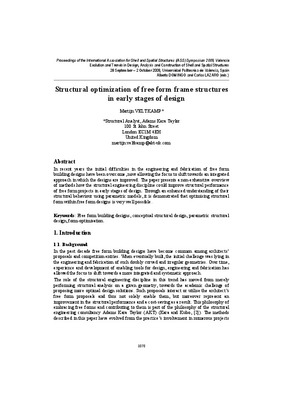JavaScript is disabled for your browser. Some features of this site may not work without it.
Buscar en RiuNet
Listar
Mi cuenta
Estadísticas
Ayuda RiuNet
Admin. UPV
Structural optimization of free form framed structures in early stages of design
Mostrar el registro sencillo del ítem
Ficheros en el ítem
| dc.contributor.author | VELTKAMP, Martijn
|
|
| dc.contributor.editor | Domingo Cabo, Alberto
|
es_ES |
| dc.contributor.editor | Lázaro Fernández, Carlos Manuel
|
es_ES |
| dc.date.accessioned | 2010-01-27T17:15:03Z | |
| dc.date.available | 2010-01-27T17:15:03Z | |
| dc.date.issued | 2010-01-27T17:15:03Z | |
| dc.identifier.isbn | 978-84-8363-461-5 | |
| dc.identifier.uri | http://hdl.handle.net/10251/6965 | |
| dc.description | p. 1078-1089 | en_EN |
| dc.description.abstract | The present paper proposes the application of topology optimisation software to generate topologically optimised building components in prestressed concrete, and the realisation of optimised shapes via large scale CNC-milling technology. Topology optimisation within architectural design holds a potential for simultaneously reducing material usage and evolving new structural morphologies that challenge the aesthetics of architectural appearance as well as the related production processes. To make topology optimisation useful to the architectural design process, possibilities of different modelling interpretations must be investigated in order to explore new ways of affecting optimisation results to meet both aesthetic requirements and structural constraints. The present paper purposes methods to imbed aesthetic assertions in the optimisation model to influence the evolving topologies in new directions while keeping initial constraints. As aesthetic values cannot reasonably be validated through numerical evaluation, only structural criteria and manufacturing constraints can be directly utilised as an objective for an algorithmic optimisation process. But as the optimisation process itself is a linear result of the optimisation algorithm, aesthetic reflections can be imbedded indirectly by evaluating initial optimisation output and applying adjustments to the model using the presented methods. The application of topology optimisation in architectural design allow for a convergence of engineering and architectural disciplines via a direct and concise dialogue between different approaches to optimisation configuration. Commercially available optimisation software solutions are targeted at the automotive-, aeronautic- and naval industries, and not yet specifically suited to meet demands of the building industry. The presented research proposes methods to model optimisation setup within existing software that meet building related optimisation issues, such as the inclusion of post-tensioning in an optimised concrete volume. | en_EN |
| dc.language | Inglés | en_EN |
| dc.publisher | Editorial Universitat Politècnica de València | es_ES |
| dc.relation.ispartof | Symposium of the International Association for Shell and Spatial Structures (50th. 2009. Valencia). Evolution and Trends in Design, Analysis and Construction of Shell and Spatial Structures : Proceedings | en_EN |
| dc.rights | Reserva de todos los derechos | en_EN |
| dc.subject | Free form building designs | en_EN |
| dc.subject | Conceptual structural design | en_EN |
| dc.subject | Parametric structural design | en_EN |
| dc.subject | Form-optimization | en_EN |
| dc.title | Structural optimization of free form framed structures in early stages of design | en_EN |
| dc.type | Comunicación en congreso | en_EN |
| dc.rights.accessRights | Abierto | es_ES |
| dc.description.bibliographicCitation | Veltkamp, M. (2010). Structural optimization of free form framed structures in early stages of design. Editorial Universitat Politècnica de València. http://hdl.handle.net/10251/6965 | es_ES |
| dc.relation.conferencename | Symposium of the International Association for Shell and Spatial Structures | es_ES |
| dc.relation.conferencedate | 2009 | es_ES |
| dc.relation.conferenceplace | Valencia | es_ES |






